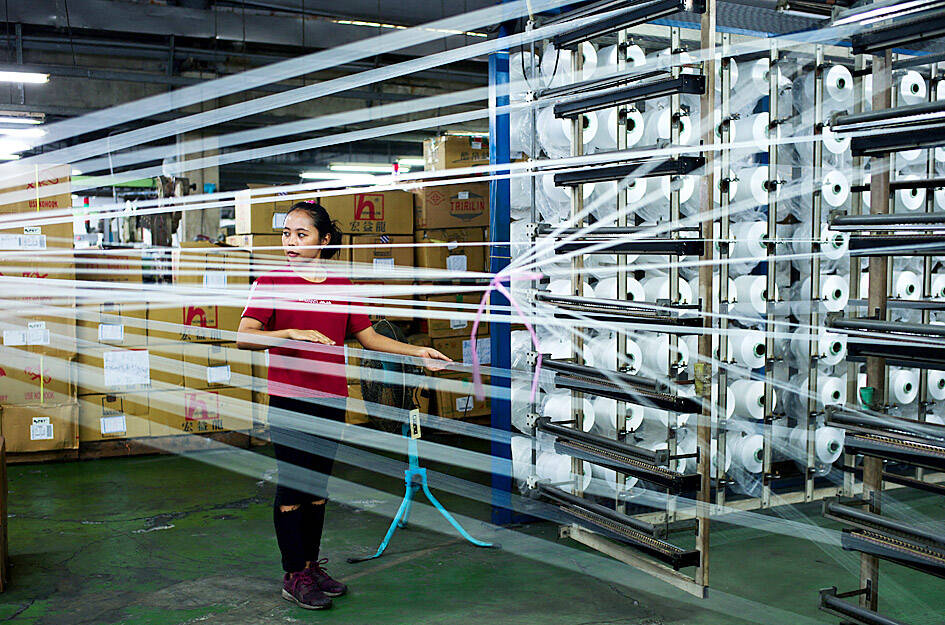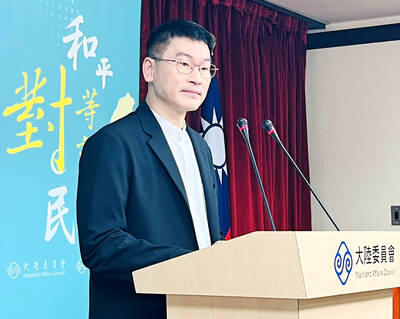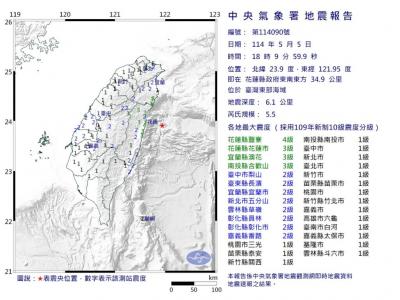Growing up on Taiwan’s west coast where mollusk farming is popular, Eddie Wang saw discarded oyster shells transformed from waste to function — a memory that inspired him to create a unique and environmentally friendly fabric called “Seawool.”
Wang remembered that residents of his seaside hometown of Yunlin County used discarded oyster shells that littered the streets during the harvest as insulation for their homes.
“They burned the shells and painted the residue on the walls. The houses then became warm in the winter and cool in the summer,” the 42-year-old said at his factory in Tainan.

Photo: Sam Yeh, AFP
“So I was curious about why oyster shells have such a miraculous effect,” he said.
Wang’s Creative Tech Textile company, established in 2010, was already producing an “eco-fabric” — a polyester material made out of recycled plastic bottles — but he felt its texture was a bit “ordinary.”
He started working with a research institute to experiment with making fabric out of oyster shell residue, in 2013 coming up with the right formula that produces a material similar to wool.
Today, his factory in Taiwan uses about 100 tonnes of oyster shells a year to churn out about 900 tonnes of Seawool, a trademarked and patented fabric.
The fabric and clothing generate about NT$200 million (US$6.24 million) a year, with the bulk of it sourced by outdoor and sustainability clothing brands in Europe and the US.
The fabric made in Taiwan would not be possible without the nation’s unique oyster farming culture, Wang said.
“This industry chain cannot be found anywhere else overseas,” he said. “We have people to harvest oysters, we have specialists to clean oyster shells, and we have people for drying and calcining [treating] oyster shells.”
Taiwan has a hefty appetite for oysters, harvesting an estimated 200,000 tonnes a year with the fleshy meat used in local cuisine such as crispy omelets and silk-like noodle dishes.
However, its popularity also means that about 160,000 tonnes of shells are discarded yearly, according to data from the Ministry of Agriculture.
They pile up on the streets of aqua-farming towns — the majority in western cities such as Yunlin, Changhua and Chiayi — causing environmental issues by emitting fishy smells and providing breeding sites for mosquitos.
At Wang’s factory, the shells are ground into nano beads and combined with yarn made from recycled plastic bottles.
“It creates a magical yarn,” he said. “Oyster shell is a material with low thermal conductivity — it does not absorb heat, nor does it dissipate heat.”
Turning the shells — which capture and store carbon dioxide from the atmosphere — into Seawool also does not require water, making it a “low-carbon product,” Wang said.
A half-hour drive from his showroom where activewear jackets, sweaters and pants are displayed, state enterprise Taiwan Sugar Corp (TSC) also has a factory that grinds discarded shells into a powder used in manufacturing household items such as incense sticks.
The crushed shells help to reduce smoke and the toxic chemicals emitted from burning incense, said Chen Wei-jen, deputy chief of TSC’s biotech business division.
“We hope oyster shells can have multiple industrial applications and interested companies can use it as a raw material to make their products more environmentally friendly and add value to their products,” Chen said.
Before the shells get to the factories, farmers in Chiayi County — famed for producing oysters — collect the mollusks at dawn from racks installed along the coast. They are sorted into baskets before being sent to plants such as Dai Sen-tai’s factory, where they are machine-washed before being sent to small family-run businesses that shuck the meat and send the shells south.
Dai, whose family has been in the oyster farming industry for three generations, said he is happy that Taiwan is breathing new life into the sea waste.
“When I was a child, no one wanted oyster shells — they were dumped and discarded everywhere,” he said. “It’s good that the waste has been turned into gold now.”

An essay competition jointly organized by a local writing society and a publisher affiliated with the Chinese Communist Party (CCP) might have contravened the Act Governing Relations Between the People of the Taiwan Area and the Mainland Area (臺灣地區與大陸地區人民關係條例), the Mainland Affairs Council (MAC) said on Thursday. “In this case, the partner organization is clearly an agency under the CCP’s Fujian Provincial Committee,” MAC Deputy Minister and spokesperson Liang Wen-chieh (梁文傑) said at a news briefing in Taipei. “It also involves bringing Taiwanese students to China with all-expenses-paid arrangements to attend award ceremonies and camps,” Liang said. Those two “characteristics” are typically sufficient

A magnitude 5.9 earthquake that struck about 33km off the coast of Hualien City was the "main shock" in a series of quakes in the area, with aftershocks expected over the next three days, the Central Weather Administration (CWA) said yesterday. Prior to the magnitude 5.9 quake shaking most of Taiwan at 6:53pm yesterday, six other earthquakes stronger than a magnitude of 4, starting with a magnitude 5.5 quake at 6:09pm, occurred in the area. CWA Seismological Center Director Wu Chien-fu (吳健富) confirmed that the quakes were all part of the same series and that the magnitude 5.5 temblor was

The brilliant blue waters, thick foliage and bucolic atmosphere on this seemingly idyllic archipelago deep in the Pacific Ocean belie the key role it now plays in a titanic geopolitical struggle. Palau is again on the front line as China, and the US and its allies prepare their forces in an intensifying contest for control over the Asia-Pacific region. The democratic nation of just 17,000 people hosts US-controlled airstrips and soon-to-be-completed radar installations that the US military describes as “critical” to monitoring vast swathes of water and airspace. It is also a key piece of the second island chain, a string of

The Central Weather Administration has issued a heat alert for southeastern Taiwan, warning of temperatures as high as 36°C today, while alerting some coastal areas of strong winds later in the day. Kaohsiung’s Neimen District (內門) and Pingtung County’s Neipu Township (內埔) are under an orange heat alert, which warns of temperatures as high as 36°C for three consecutive days, the CWA said, citing southwest winds. The heat would also extend to Tainan’s Nansi (楠西) and Yujing (玉井) districts, as well as Pingtung’s Gaoshu (高樹), Yanpu (鹽埔) and Majia (瑪家) townships, it said, forecasting highs of up to 36°C in those areas